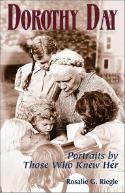Issue Date: January 9, 2004
A new book tells more about the influential woman who was a sinner who tried By TIM UNSWORTH Dorothy Day could talk the ears off a brass monkey. Some years ago, I stood in the back of a jammed DePaul University auditorium in Chicago while she strung one sentence after another together. But it was all good stuff. No blather. Her close friend Nina Polcyn Moore once said of her, “She brought such richness to the work. [She] larded her conversations with so many references that she was a delight to listen to. Such a school she was!” At the time, I was a flunky for the university’s president. When the nearly half-pound St. Vincent de Paul Medal she was to receive arrived without a box, I had to run to a nearby jewelry building to get a presentation box made. “I know her,” the box maker said. “I do the boxes for the Laetare Medal for Notre Dame. She got one of those.” Then he added with pride: “You know Hefner? The Playboy guy? I do the boxes for his bunny medals.” Dorothy Day would have gotten a kick out of that. As it was, she laughed when the manhole-size medal was presented and said: “Oh, my, I thought I could pin it on my sweater with my Debs medal.” (Eugene V. Debs, 1855-1926, was an American labor organizer who ran for president five times on the Socialist ticket.) When she finished, Dorothy Day was given a generous check. However, the university had to cash it for her. She had no bank account. Those are just a few of my stories. Rosalie G. Riegle, professor emerita of English at Saginaw Valley State University in Michigan, met Dorothy Day only once, in 1969, but the experience “stuck in her craw,” as Riegle’s father said. In 1983, she began interviewing 208 people for her first book on Day and the Catholic Worker movement. She conducted 134 interviews for her second book, Dorothy Day: Portraits by Those Who Knew Her, published recently by Orbis Books. The result is a detailed portrait of a complex woman who, according to Fr. Harvey Egan, a retired pastor and clerical maverick from Minneapolis, was “strictly business.” He added: “She paid more attention to the poor than to seminarians and others. … She was not brusque with them, but she didn’t get caught in many hand-holding, long discussions with people. She knew how to get the work done.” But she enjoyed a dab of perfume and a dash of other cosmetics. Little wonder that Holy Cross historian David O’Brien called her “the most interesting and influential Catholic of the 20th century,” a line that O’Brien claims has been quoted more than anything else he has written. Most of those interviewed were elderly -- waiting for God. (Fourteen died before the interview phase ended in early 2002.) I am proud to claim that I came to know at least 13 of the 91 souls who are profiled in the back of the book, together with at least a dozen others who played smaller roles. They and the others are an index of the incredibly diverse people who touched souls with Dorothy. She respected the hierarchy, even the late Cardinal Francis Spellman of New York, whom she criticized often but always supported. She was a radical and a traditionalist who ran the whole show but took down the posted house rules once she was told that they hobbled personalism. She admired Mother (now Blessed) Teresa, but they were different. Mother Teresa never questioned the social structures that produced millions of poor people. She simply fed and nursed them. Dorothy Day questioned the structures. However, like Mother Teresa, according to colleague John Cort, she made all the decisions, all the rules. “Or [she] took down the rules.” Nina Polcyn Moore, one of Day’s closest friends for decades (she once bailed the stubborn radical out of jail), appears in Riegle’s book at least 13 times. “We’d all grown up like the Bobbsey Twins and she led a bohemian life,” Nina said. “I don’t know what a mystic is, but she must have been one.” Other samples: “I don’t think we would have gotten as far in our social conscience without Dorothy and the Catholic Worker. … A person like Dorothy is almost impossible to duplicate. Maybe no one will ever want those boots.” There is also a story involving the soup kitchen that was part of every Catholic Worker house. (There were at least 180 of them established in her lifetime.) One night, after feeding the poor and homeless, the staff sat down for their meal, which was virtually a duplicate of the meal served to the guests. Just one exception: The staff had butter. A few of the staff began murmuring that the guests had not had butter and that this sort of privilege was out of bounds. (Typically, they were among the ones who complained a lot but did little work.) Dorothy just looked up from her soup and said: “Oh, shut up!” This book is so dense with insights that you just have to read it. A mutual friend, Ed Marciniak, recalled that Dorothy taught us “what was really happening.” Was Dorothy a saint? These brief portraits “by those who knew her” depict a sinner who tried, a bright, earthy person who sometimes used barnyard language, who had some affairs, went through an abortion and had a daughter by an agnostic without benefit of sacrament -- a man who came to her funeral, shed tears and tossed a rose into her grave. “Don’t call me a saint,” she said. “I don’t want to be dismissed that easily.” Tim Unsworth writes from Chicago where he lives not far from the church in which Dorothy Day was baptized into the Episcopal church as a child. He can be reached at unsworth@core.com. National Catholic Reporter, January 9, 2004 |
